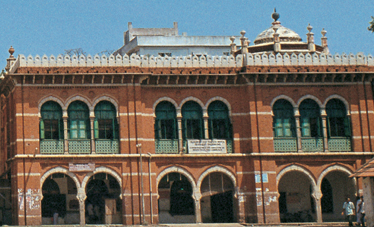 |
Khalsa Mahal |
In what may be the first of its kind, the State Government has decided to rope in a conservation architect to advise on the restoration of the fire-ravaged Khalsa Mahal at Chepauk Palace. This is perhaps an indication that the Government has come to accept that its conventional (read PWD) methods will not work in heritage conservation. If that is so, it is indeed a welcome development.
Initiating the process recently, the Government has invited expressions of interest from conservation architects. The selected professional will have to work on a conceptual plan, architectural and structural designs, and prepare detailed estimates. Tenders will then be floated for the actual execution and the architect will be closely involved in the final work. It is learnt that the Government intends to closely watch this project as a pilot and this may lead the way for future conservation efforts as well.
This is a marked departure from earlier practice. Till now, all conservation projects by the Government have more or less been worked on the same basis as new constructions. The same procedures and rates apply. With the PWD not having any conservation experts on its roles, work on restoration of Government-owned heritage buildings has been shoddy, at best. That these are very hardy and robust structures that manage to survive despite such treatment is another matter altogether. The strict adherence to Government rates for heritage restoration is also an impossibility. Most often, the true nature and extent of damage reveals itself only after work has actually begun. This calls for a flexibility in cost estimates which is not permissible at present.
Chepauk Palace, which is arguably the first example of Indo-Saracenic style of architecture, was ravaged by a fire in early January this year. Its subsequent story is in itself a tale of how heritage restoration is gradually acquiring centre-stage. After an initial and hasty announcement that the building was beyond redemption and would be demolished, better sense prevailed. A team of three experts was put together by the Government. Though the composition of the team was a subject of controversy, it did submit a report that recommended conservation and restoration. The exact nature of the restoration is, however, rather nebulously given in the report and it remains to be seen as to how exactly this will pan out on the ground. Much will depend on the conservation architect selected and what weight his/her opinion will carry.
If this project is successful, Chepauk Palace can claim yet another first to its credit. It will be the first fire-ravaged heritage building in the State to be professionally restored. Moore Market, Gandhi Illam and Spencers' are all examples of buildings that were gutted but what could have been conserved had there been a vision and a will. Perhaps Chepauk Palace will show the way, as it did by way of architecture in the erstwhile British empire for almost two centuries.
One last thought, though. In report about these government plans, the word 'rebuilt' has been used several times. We hope/restoration is what is planned and not pulling it all down and building a replica – which is what 'rebuilding' implies.
|

